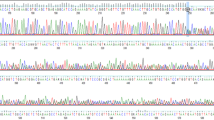Abstract
We evaluated the contribution of an Alu insertion in BRCA2 exon 3 (c.156_157insAlu) to inherited predisposition to breast/ovarian cancer in 208 families originated mostly from northern/central Portugal. We identified the c.156_157insAlu BRCA2 mutation in 14 families and showed that it accounts for more that one-fourth of deleterious BRCA1/BRCA2 mutations in breast/ovarian cancer families originated from this part of the country. This mutation originates BRCA2 exon 3 skipping and we demonstrated its pathogenic effect by showing that the BRCA2 full length transcript is derived only from the wild type allele in carriers, that it is absent in 262 chromosomes from healthy blood donors, and that it co-segregates with the disease. Polymorphic microsatellite markers were used for haplotype analysis in three informative families. In two of the three families one haplotype was shared for all but two markers, whereas in the third family all markers telomeric to BRCA2 differed from that observed in the other two. Although the c.156_157insAlu BRCA2 mutation has so far only been identified in Portuguese breast/ovarian cancer families, screening of this rearrangement in other populations will allow evaluation of whether or not it is a population-specific founder mutation and a more accurate estimation of its distribution and age.



Similar content being viewed by others
References
Tonin P, Serova O, Lenoir G et al (1995) BRCA1 mutations in Ashkenazi Jewish women. Am J Hum Genet 57:189
Durocher F, Tonin P, Shattuck-Eidens D et al (1996) Mutation analysis of the BRCA1 gene in 23 families with cases of cancer of the breast, ovary, and multiple other sites. J Med Genet 33:814–819
Tonin PN, Mes-Masson AM, Futreal PA et al (1998) Founder BRCA1 and BRCA2 mutations in French Canadian breast and ovarian cancer families. Am J Hum Genet 63:1341–1351
Dørum A, Hovig E, Tropé C et al (1999) Three per cent of Norwegian ovarian cancers are caused by BRCA1 1675delA or1135insA. Eur J Cancer 35:779–781
Peelen T, Cornelis RS, van Vliet M et al (1996) The majority of 22 Dutch high-risk breast cancer families are due to either BRCA1or BRCA2. Eur J Hum Genet 4:225–230
Petrij-Bosch A, Peelen T, van Vliet M et al (1997) BRCA1 genomic deletions are major founder mutations in Dutch breast cancer patients. Nat Genet 17:341–345
Górski B, Jakubowska A, Huzarski T et al (2004) A high proportion of founder BRCA1 mutations in Polish breast cancer families. Int J Cancer 110:683–686
Konstantopoulou I, Rampias T, Ladopoulou A et al (2008) Greek BRCA1 and BRCA2 mutation spectrum: two BRCA1 mutations account for half the carriers found among high-risk breast/ovarian cancer patients. Breast Cancer Res Treat 107:431–441
Anagnostopoulos T, Pertesi M, Konstantopoulou I et al (2007) G1738R is a BRCA1 founder mutation in Greek breast/ovarian cancer patients: evaluation of its pathogenicity and inferences on its genealogical history. Breast Cancer Res Treat. doi:10.1007/s10549-007-9729-y
Rafnar T, Benediktsdottir KR, Eldon BJ et al (2004) BRCA2, but not BRCA1, mutations account for familial ovarian cancer in Iceland: a population-based study. Eur J Cancer 40:2788–2793
Campos B, Díez O, Odefrey F et al (2003) Haplotype analysis of the BRCA2 9254delATCAT recurrent mutation in breast/ovarian cancer families from Spain. Hum Mutat 21:452
Díez O, Osorio A, Durán M et al (2003) Analysis of BRCA1 and BRCA2 genes in Spanish breast/ovarian cancer patients: a high proportion of mutations unique to Spain and evidence of founder effects. Hum Mutat 22:301–312
Bergman A, Einbeigi Z, Olofsson U et al (2001) The western Swedish BRCA1 founder mutation 3171ins5; a 3.7 cM conserved haplotype of today is a reminiscence of a 1500-year-old mutation. Eur J Hum Genet 9:787–793
Peixoto A, Salgueiro N, Santos C et al (2006) BRCA1 and BRCA2 germline mutational spectrum and evidence for genetic anticipation in Portuguese breast/ovarian cancer families. Fam Cancer 5:379–387
Teugels E, De Brakeleer S, Goelen G et al (2005) De novo Alu element insertions targeted to a sequence common to the BRCA1 and BRCA2 genes. Hum Mutat 26:284
Machado PM, Brandão RD, Cavaco BM et al (2007) Screening for a BRCA2 rearrangement in high-risk breast/ovarian cancer families: evidence for a founder effect and analysis of the associated phenotypes. J Clin Oncol 25:2027–2034
Díez O, Gutiérrez-Enríquez S, Ramón y Cajal T et al (2007) Caution should be used when interpreting alterations affecting the exon 3 of the BRCA2 gene in breast/ovarian cancer families. J Clin Oncol 25:5035–5036
Parmigiani G, Berry D, Aguilar O (1998) Determining carrier probabilities for breast cancer-susceptibility genes BRCA1 and BRCA2. Am J Hum Genet 62:145–158
van der Hout AH, van den Ouweland AM, van der Luijt RB et al (2006) A DGGE system for comprehensive mutation screening of BRCA1 and BRCA2: application in a Dutch cancer clinic setting. Hum Mutat 27:654–666
Claes K, Poppe B, Coene I et al (2004) BRCA1 and BRCA2 germline mutation spectrum and frequencies in Belgian breast/ovarian cancer families. Br J Cancer 90:1244–1251
Perkowska M, BroZek I, Wysocka B et al (2003) BRCA1 and BRCA2 mutation analysis in breast-ovarian cancer families from northeastern Poland. Hum Mutat 21:553–554
Shih HA, Couch FJ, Nathanson KL et al (2002) BRCA1 and BRCA2 mutation frequency in women evaluated in a breast cancer risk evaluation clinic. J Clin Oncol 20:994–999
Judkins T, Hendrickson BC, Deffenbaugh AM et al (2005) Single nucleotide polymorphisms in clinical genetic testing: the characterization of the clinical significance of genetic variants and their application in clinical research for BRCA1. Mutat Res 573:168–179
Rowold DJ, Herrera RJ (2000) Alu elements and the human genome. Genetica 108:57–72
Oros KK, Leblanc G, Arcand SL et al (2006) Haplotype analysis suggest common founders in carriers of the recurrent BRCA2 mutation, 3398delAAAAG, in French Canadian hereditary breast and/ovarian cancer families. BMC Med Genet 7:23
Author information
Authors and Affiliations
Corresponding author
Rights and permissions
About this article
Cite this article
Peixoto, A., Santos, C., Rocha, P. et al. The c.156_157insAlu BRCA2 rearrangement accounts for more than one-fourth of deleterious BRCA mutations in northern/central Portugal. Breast Cancer Res Treat 114, 31–38 (2009). https://doi.org/10.1007/s10549-008-9978-4
Received:
Accepted:
Published:
Issue Date:
DOI: https://doi.org/10.1007/s10549-008-9978-4




